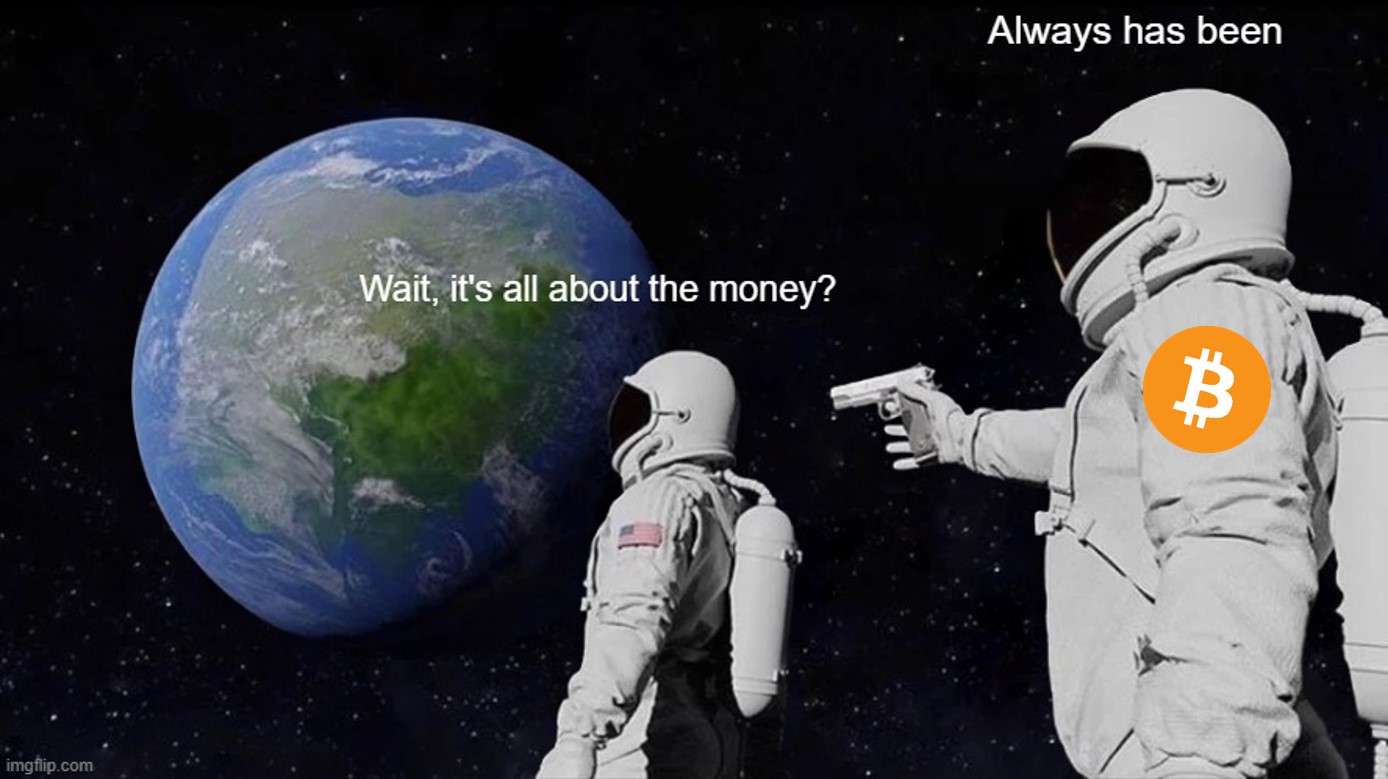
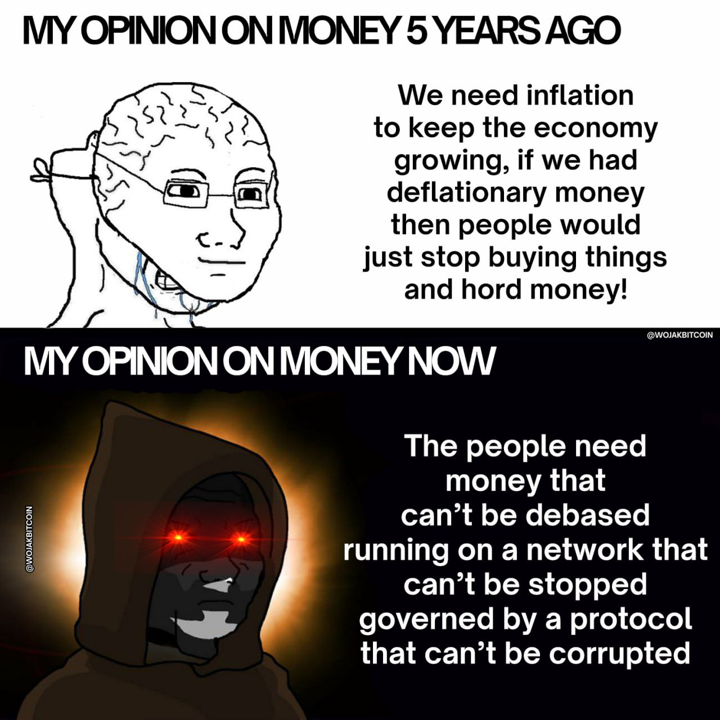
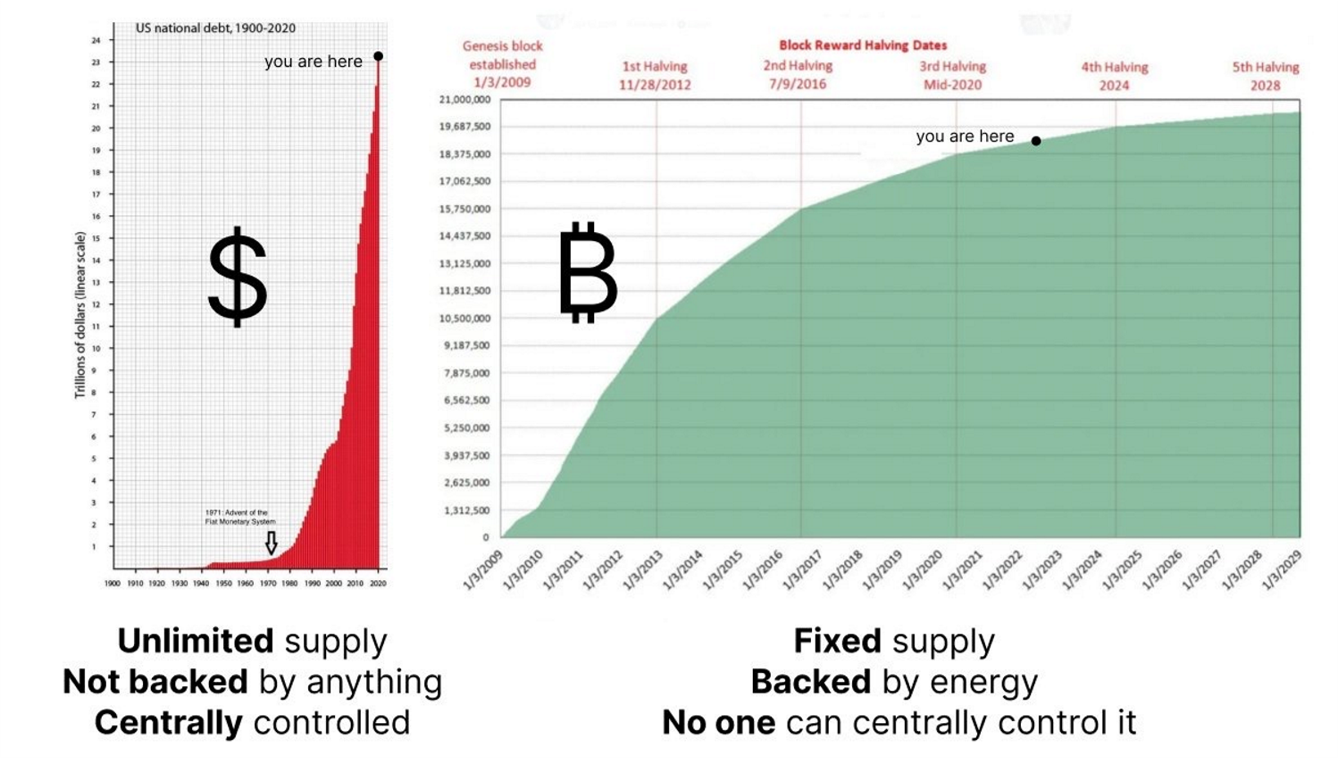








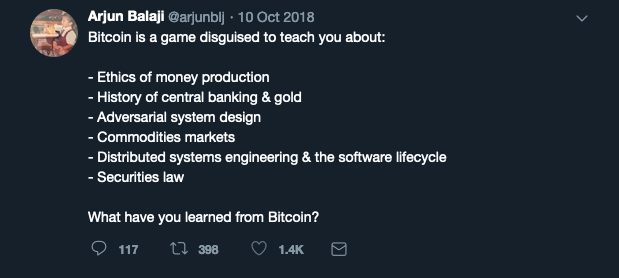


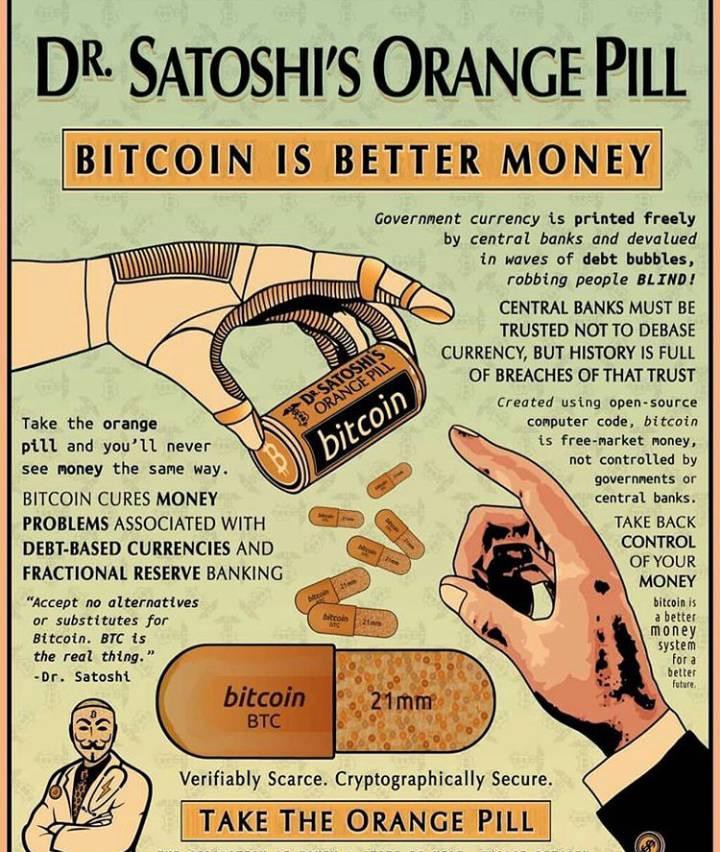





















































Bitcoin is a system for electronic transactions without relying on trust
Satoshi Nakamoto

Money at its core is a system of trust, a social construct if you will. But as we’ve seen time and time again, this trust has been betrayed.
In the wise words of Satoshi:
The root problem with conventional currency is all the trust that’s required to make it work. The central bank must be trusted not to debase the currency, but the history of fiat currencies is full of breaches of that trust. Banks must be trusted to hold our money and transfer it electronically, but they lend it out in waves of credit bubbles with barely a fraction in reserve.
Satoshi Nakamoto
The truth is, the trust in our global monetary system is broken. Wherever you look you’ll find a slow erosion of faith in our institutions.
But for good reason.
Scandals have plagued our financial institutions throughout our modern history. From inflation and fractional reserve bank runs, to the 2008 global financial crisis, to money laundering and straight up fraud.
Money is used by authoritarian regimes as a tool of control, oppressing billions of the poorest people on earth. Wealth is extracted from society through monetary debasement and interest rate manipulation, and concentrated in the hands of the well-connected. And debt slavery is systematically leveraged to social engineer a permanent working class.
Not only are the poor and middle class of the western world trapped in this hamster wheel, but also entire sovereign nations, through IMF structural adjustment loans and China’s Belt and Road initiative.
Unfortunately none of this is new. Throughout history, trust in money has been abused and manipulated, leading to breakdowns and inefficiencies in society.
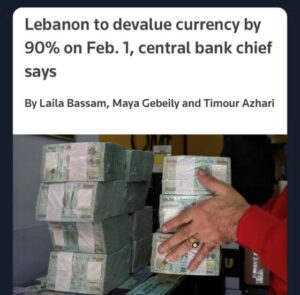
That’s where Bitcoin comes in.
Bitcoin is revolutionary because it’s a trust machine. Bitcoin manufactures trust because there are no humans that run it or rule over it. Instead you are trusting in math, physics, code, and probabilities.
Bitcoin’s trust is based on a globally decentralized network of tens of thousands of computers that maintain the integrity of the system. Bitcoin is the largest and most secure supercomputer on earth by many magnitudes. Transactions are recorded on an immutable ledger, a record that can’t be changed or destroyed and is constantly being audited. Bitcoin is money which is held in the most secure vaults in human history, money which can’t be controlled or debased, and money which can’t be unfairly counterfeited to insiders.
It’s kind of like putting a calculator in charge of a global financial and monetary system. A calculator that can’t be hacked and whose code is fully transparent, leading to a fully trustworthy and fully rules based economic system.
Unlike today’s currency which is maintained by banks, corporations, and governments, bitcoin is open source software, a banking system that is instead run on top of the internet.

Bitcoin is a global economic project maintained by developers all over the world, permissionlessly built on by entrepreneurs and academics, and run by human rights groups, democracy protesters and money nerds.
Because of this decentralization and immutability, bitcoin is incredibly secure and resistant to fraud and corruption. Unlike traditional banking, where a single point of failure can bring down the entire system, and where assets are actually just a chain of debt based liabilities, bitcoin’s distributed network is virtually invincible. Bitcoin is digital gold, a barer asset with no debt or counterparty risk.
Bitcoin is truth because all transactions are made without trust. All disputes are solved through physics and all ownership is enforced by cryptography. This is an automated justice system programmed into software, software that’s incorruptible, secure, and eternal.
The entire point of bitcoin is to remove the distribution, production, and control over money from humanity. And the corruption that comes with it.
This is trust in math, trust in code, not in humans.
The trust machine is a revolutionary new technology that has the potential to completely upend our existing financial system.
While traditional banking and payment systems heavily rely on trust, Bitcoin offers a way out of this system…Such a framework allowed the creation and implementation of a system effectively disjoined from government control, delivering a revolutionary separation of money and state for the first time in history.
Bitcoin Magazine
Bitcoin’s breakthrough was solving the byzantine generals problem, a computer science problem once thought impossible to solve. Satoshi discovered a way for people to coordinate with digital money without needing to trust each other. Instead of blindly believing the benevolence of third parties like banks or corporations, bitcoin manufactures truth through a global competition, leveraging the physical laws of nature and energy to keep the system incorruptible.
You can trust that bitcoin won’t cheat you, because bitcoin is code. Bitcoin’s neutrality as computer software means it holds no national, political or institutional allegiance. Bitcoin doesn’t know your economic status, age, religion, gender, ethnicity, or political views. Bitcoin doesn’t know who you are, or what you are. It doesn’t know if you’re a car, a refrigerator, or a drone. All it knows is code. It has simple rules. If you want to unlock the vault and send a unit of bitcoin, you have to provide the keys.
Bitcoin is a whole new monetary and financial system that’s based on uncontrollable money. The temptation of unlimited wealth has been taken away from human beings and because of that society will flourish.

How can I trust that when I send you a bitcoin, you won’t cheat me and just spend it twice? How can I trust that you will follow the rules? How can we both agree on how much bitcoin each of us owns? Information can just be copied over and over on the internet, in fact that’s the point.
If you have an apple, and I have an apple, and we exchange apples, then you and I will still each have one apple.
But if you have an idea, and I have an idea, and we exchange these ideas, then each of us will have two ideas.
George Bernard Shaw
In order to solve this problem, Satoshi had to invent digital scarcity. He had to put physics into the internet. She had to recreate the law of conservation of energy, within cyberspace.
To accomplish this task, he created a decentralized ledger, the first accounting innovation in over 700 years. Decentralized ledger just means that everyone is checking every transaction at all times, and everyone has access to the entire history of the ledger, for a fully transparent and fully secure money system.
And to secure this ledger, she had to program a global game theoretic competition, a lottery where players inadvertently help create a force field around the network, protecting it from bad actors.

Bitcoin is special because this had never been done before, and has yet to be replicated since. Every other blockchain can be changed by some powerful special interests. Bitcoin is unique in the cryptocurrency space because it’s the only immutable unchanging immortal and invincible network in the world.
Therefore, bitcoin has value because you can guarantee transactions are legitimate. You can trust that the ledger isn’t fraudulent. You can trust that the money is really yours. You can verify for yourself that you are in possession, and that no one can change the rules. Bitcoin is property rights codified.
A common motto of bitcoiners is “don’t trust, verify”. For the first time, we have a system of money where anyone can verify for themselves their money is real, and the rules of the monetary system are being followed. When it comes to money, people are incentivized to cheat. To take the easiest path possible. And for thousands of years humanity has faced this wealth confiscation dilemma, where we had to trust someone else with our savings.
When designing bitcoin Satoshi flipped the incentive structure on its head. Bitcoin ensures that everyone will follow the rules, because following the rules is what makes you the most money. Bitcoin was specifically designed with game theory to encourage fair play and participation, and make the cost to attack prohibitively expensive.
Bitcoin mining doesn’t just reward newly minted bitcoins, it creates a force field of computational power dedicated to supporting the honest chain of transactions. Fraudsters, hackers, sociopaths, and kings can’t change the rules, steal wealth, or cheat the system. In fact, they play along with the rest of us to acquire the soundest money in human history.
I think it’s helpful to picture bitcoin as “The great excel spreadsheet in the sky”. Think of it like the ultimate global google doc. It’s a shared spreadsheet in the cloud, freely accessible to anyone, and is just a long list of transactions. That’s literally all bitcoin is, it’s a ledger, a list of who sent money to who.
Ok that’s all well and good, but this great excel spreadsheet in the sky, why is that revolutionary?
Ok well let’s spice up the metaphor a bit – bitcoin is digital gold right? So instead of the excel sheet in the sky, think of it more like a golden tablet in the clouds, or on cyberspace mountain. This is some Moses shit. Carved into the enormous golden tablet is a list of all of the bitcoin in the world, who sent it to who and who owns it now.

Once you send some bitcoin to someone, a new line is magically carved into the tablet and it stays there forever. Anyone can see this golden tablet, it’s open and transparent and visible to all, but no one can undo transactions once they’re carved. No one can actually touch this tablet and no one can change the rules. It exists beyond the clutches of humanity. We’ve created something we can’t stop.
This is the trust machine.
You can trust bitcoin because it’s secured by math and by code. You can trust the golden tablet because it’s not controlled by humans. You can trust the trust machine because it exists beyond trust.
Because the network exists beyond humanity, bitcoin can be compared to the unchanging and automatic laws of physics. This is the law of the conservation of energy written into computer software. When you send bitcoin to someone, it’s like physically handing them a piece of gold.
There is no third-party involved when you hand gold to someone. Gold is an element from nature, literally a rock, and physics governs the rules to hand a rock to someone else.
Bitcoin is the gold in this analogy, but it’s also the physics. Bitcoin is the money and the network. It’s both the matter and the gravity. bitcoin is the gold and Bitcoin facilitates the transfer.
Except of course this is all existing in cyberspace, a borderless and permissionless global network. A programmable and unstoppable money transfer protocol. The world’s most powerful supercomputer beaming value at the speed of light to anyone, anywhere, any time.
Bitcoin was designed to be simple, have no loopholes, be incredibly secure, and do one job and do it better than anything else. It doesn’t have any bells or whistles and it doesn’t try to be anything that it’s not. Bitcoin is sound money, the best money humanity has ever had.
The purpose of bitcoin is to bring full sovereignty to the individual, and to remove all dependencies on trusted third parties. No rulers, no master, no hosts, only peers
GiGi
Bitcoin removes humans from the control over money, it obsoletes the entire existing global monetary framework, it replaces a system of money that is manipulated, debased, and untrustworthy, to one that you can trust. A system where the rules can’t be changed to benefit the rich and powerful. A system where no matter how much bitcoin you have, you can’t alter the tablet. THAT is monetary revolution.
The mystery of Satoshi Nakamoto is not a story the Sith would tell you
And yet it is one of the most fascinating legends ever told
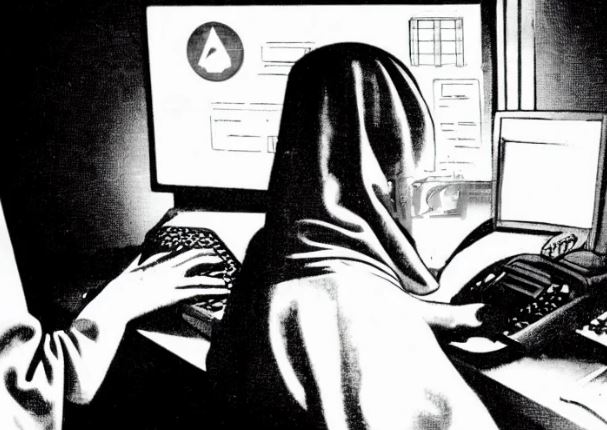
It’s the story of a cryptic computer scientist, an unknown person or a group of people whose invention has changed human civilization forever.
Unlike many legends of past, this story takes place in the modern, digital age, where everything is tracked and logged. Satoshi’s communications are publicly available to read, and yet the details around her identity are still shrouded in mystery.
Let’s turn back the clocks to the year 2008
In the midst of a global financial crisis, the worst economic emergency since the great depression, and *almost* the most cataclysmic economic event in the history of mankind…
A shadowy figure quietly emerges
They call them-self Satoshi Nakamoto
To calm markets and suppress a meltdown, emergency measures are taken by world governments, flooding the economy to the tune of hundreds of billions of dollars in bailouts.
Our political and economic leaders barely save us from catastrophe, as the entire world is thrust into recession. Global debt reaches record levels, with the consequences merely postponed…
The date is October 31st
On a Halloween night, against the backdrop of this global crisis, this mad computer scientist quietly published the instructions to a new kind of money. A digital money, an unstoppable money, ruled by no human being. An invention they call bitcoin.
A purely peer-to-peer version of electronic cash would allow online payments to be sent directly from one party to another without going through a financial institution.
Satoshi Nakamoto
In a time where overleveraged financial institutions had risked the solvency of the global economy, the seeds of rebellion were planted. A revolutionary new economic system was born.
For you see, this unknown inventor of bitcoin, was a Cypherpunk
The Cypherpunks were a group of rogue anti-authoritarian computer programmers, digital liberty advocates and anarchists. Computer scientists who were terrified of a future Orwellian surveillance state.
They decided to take freedom into their own hands, creating technology no government or corporation could stop.
And independent money was their holy grail.
The Cypherpunks had been diligently working towards the perfect digital money for decades. Their aim was to free humanity from the regulation and control of banks and middlemen, and to move money privately, without permission, and without censorship. The separation of money and state.
Standing on the shoulders of the Cypherpunk giants, Satoshi had a breakthrough.
No one ever meets this person. No one even knows if they are a single person or a group. No one ever hears her voice and no one ever sees his face.
That’s because there’s no one actually named Satoshi Nakamoto. It’s a pseudonym, a disguise, a mask.
Like a real life superhero, they conceal their identity from the world. All communication was done digitally through forum posts and email. Through meticulous planning, evasive linguistic tactics, and unpredictable posting times, Satoshi left no traceable personal clues in their writing.
In their whitepaper published on that fateful Halloween, Satoshi presents a solution to a computer science dilemma, a problem once thought impossible to solve.
Simultaneously reinventing one of the oldest technologies in human civilization, and solving a multi-thousand-year-old trust problem, with the first accounting innovation in over 700 years, Satoshi created a trust machine that runs on its own without human involvement. Eliminating the need to trust in institutions like banks, corporations or governments.
Satoshi discovered a way to put physics into the internet, to recreate the thermodynamic law of conservation of energy, within cyberspace. Satoshi discovered a new form of time, a decentralized clock, that ticks for eternity. Satoshi discovered a way to give everyone on earth access to immutable money, a revolution in property rights.
Her invention has profound consequences for the history of mankind. Completely altering our relationship with technology and the future of the internet.
For a couple of years, this mysterious computer scientist worked with volunteers to bootstrap the project. Fixing bugs and tweaking the code. And then suddenly…disappears. Like a ghost.
It’s a departure without a display. She simply leaves. They stop answering questions and emails, and he stops participating in discussions.
No one ever finds out who they are, where they came from or where they went. Satoshi remains unknown to this very day.
But with its creator gone, what is to become of this digital money project? Does it fade away into obscurity?
Quite the opposite, bitcoin jolts to life, its thunder is heard around the world.
Bitcoin went on to become the fastest trillion dollar valuation of any asset in history, at an adoption pace faster than the internet itself. Spawning an entirely new asset class and industry, and tens of thousands of other projects.
The invention of bitcoin marked a fundamental breakthrough in computer science, information theory, economics, fintech and cryptographic systems.
Now the largest supercomputer on earth, bitcoin is completely immortal. It can’t be shut down, it can’t be hacked, it can’t be banned, it can’t be changed, and it can’t be controlled. Even the most powerful governments, corporations and institutions in the world are powerless to stop it.
It is a self-running software program designed to last forever.
No one knows how it’s possible for Satoshi to both solve this unsolvable computer science problem and build an all-powerful, self-sustaining monetary system at the same time.
To be a polymath, specialized across multiple academic disciplines, and yet evade detection. The field of experts in distributed systems engineering is so small you would think it would be simple to nail them down, and yet there have been no definitive leads.
Is Satoshi an alien? A time traveler? A secret government organization? A libertarian nerd in his mother’s basement? It’s very possible that Satoshi isn’t even alive anymore. It’s been well over a decade and still no one can unmask her Halloween disguise.
By disappearing Satoshi left behind ultimate fame, power, and fortune. Adding to the mystery.
It’s estimated that Satoshi is in direct control of over one million bitcoins, and yet the coins have never been touched. Satoshi can anonymously move or sell their bitcoin whenever they want.
The fact that this treasure has sat dormant since 2010 leads many to believe that it’s unlikely Satoshi is ever coming back. If someone had access to that kind of money, they probably would have used some of it by now.
Instead, Satoshi’s treasure sits untouched as a monument to their selflessness.
Satoshi’s treasure is becoming the largest pile of money in history. In only a few years Satoshi is expected to be the richest person in the world, as the value of their fortune surpasses $300 billion. It’s predicted that this treasure surpasses a trillion dollars in value as soon as the 2030’s.
Because bitcoin’s blockchain is completely transparent, the wallets that hold Satoshi’s treasure are publically available for all to see, and yet remain completely untouchable. To compute even one of Satoshi’s keys would take until the heat death of the universe.
Satoshi’s treasure lies there mocking the old guard of money, the financial institutions he so adamantly dismayed. It lies there as a testament to the power of the individual, proving that anything is possible. And it lies there taunting those who are driven by greed, selfish minds who only seek out fortune and fame, proving that humans are capable of throwing it all away for the good of humanity.
It lies there forever jeering: “Here lies Satoshi’s legendary treasure — take it, if you can”
…
For many years to come, the mystery of Satoshi Nakamoto will continue to incite awe and astonishment as people first learn about bitcoin’s humble origins. People from around the world will marvel at the genius of Satoshi and speculate on their identity and motivation. Classes will be taught on bitcoin and the chapter dedicated to Satoshi will inspire generation after generation.
We will probably never know who invented bitcoin. The moral of the story isn’t to speculate on who Satoshi is, but to understand that it doesn’t matter.
Satoshi gave bitcoin as a gift to humanity. We run bitcoin and we decide it’s future. There’s no one in charge now, bitcoin belongs to everyone. We are all equal participants in the network.
We are all Satoshi
________________________________________________________________________________
https://tomerstrolight.medium.com/the-legendary-treasure-of-satoshi-nakamoto-c3621c5b2106
https://money.cnn.com/2014/08/27/news/economy/ben-bernanke-great-depression/index.html
https://steemit.com/ripple/@mooncryption/the-truth-behind-ripple-and-why-i-sold-it-all
Unmasking The Creator Of Bitcoin
https://hackernoon.com/the-genesis-block-and-the-phantom-a-story-of-satoshi-nakamoto
Money doesn’t grow on trees, because if it did we would call it leaves.

Everyone intuitively understands that in order for something to have value it must also be scarce, or hard to come by. It’s the same reason air is free and a Denny’s Grand SlamTM isn’t.
Bitcoin has value because it is absolutely scarce – there is a cap of 21 million bitcoins that can ever be mined. Before bitcoin was invented, digital assets could be infinitely copied, there was no such thing as digital property, and scarcity in the digital realm was thought to be impossible.
The invention of Bitcoin marked a fundamental breakthrough in computer science and cryptographic systems, enabling absolute scarcity. And after 15 years and thousands of other cryptocurrencies, bitcoin remains the only money that is perfectly scarce and verifiably finite.
This is bitcoin’s unique value proposition.
Bitcoin is often compared to digital gold because of its scarcity, but unlike gold bitcoin is finite. There will only ever be 21 million bitcoin. This limit will never change thanks to bitcoin’s network effects, unparalleled decentralization, incentive structure, and governance model.
This limit is called bitcoin’s hard cap, it is written into Bitcoin’s source code and enforced by all participants running the bitcoin software.
You can think of bitcoin as the Mona Lisa, or a plot of land in Manhattan, or Wu-Tang Clan’s Once Upon a Time in Shaolin broken up into a couple quadrillion little pieces. When you own bitcoin you own a piece of something unique, something limited and one of a kind.
The reason this is so special is because no other money or digital asset possesses an unchangeable absolutely scarce monetary policy on the level of bitcoin. Bitcoin’s rules are set in stone, it’s the most certain, reliable, and credible monetary policy of any digital asset and of any currency.
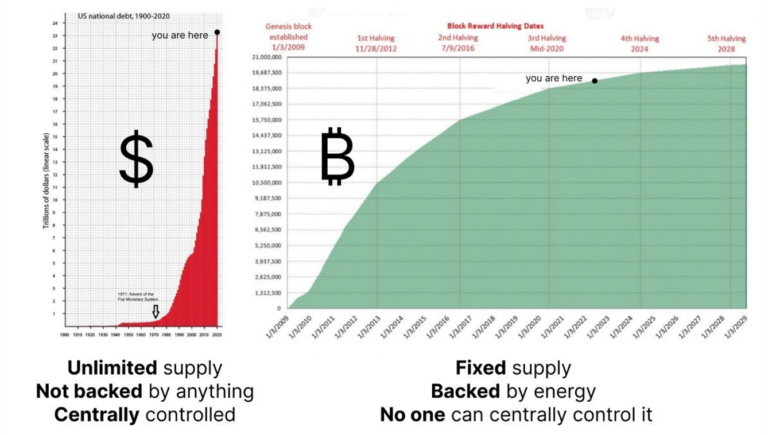
Bitcoin is backed by its unique value proposition as being the only monetary good that ever has, and will ever be, absolutely scarce. This certainty of its supply and supply schedule is unique to bitcoin and can’t be recreated.
This fixed supply is the reason bitcoin is the perfect store of value, and is the best savings technology ever invented.
The intrinsic value of this one-of-a-kind absolutely scarce monetary policy, paired with bitcoin’s perfect supply inelasticity and unparalleled stock to flow ratio, will act like a game theoretic Schelling point to global bitcoin adoption.
As Chris Kuiper and Jack Neuruter of Fidelity Digital Assets describe in their report, Bitcoin First:
One of the primary reasons investors attribute value to bitcoin is its scarcity. Its fixed supply is the reason it has the ability to be a store of value.
Bitcoin’s predictable and fixed supply has been specifically cited by wealth managers like Paul Tudor Jones and financial institutions such as Fidelity and BlackRock to highlight this unique investment thesis.
The examples of legacy financial institutional involvement into bitcoin are vast, however notably Fidelity is adding bitcoin to its 401k products, and adding bitcoin trading to its brokerage platform, and BlackRock is providing its clients with direct bitcoin exposure as well as a spot bitcoin private trust and became the largest financial institution in the world to file for a spot bitcoin ETF. In addition to Blackrock several other financial giants have submitted their own ETF’s including VanEck, ARK Invest, WisdomTree, Valkyrie, Bitwise, Fidelity and Invesco – totaling over 27 Trillion in assets under management.
The sectors that bitcoin aims to disrupt are MUCH larger than you could possibly know, we’re talking multi-trillion dollar industries all over the world.
We’re talking pristine international collateral! A global monetary settlement machine, central bank reserve asset, corporate treasury reserve asset, pension and retirement fund savings technology, inflation hedge, fiat credit default swap insurance, seizure resistant store of value, emerging market currency, international remittance network, and even the base layer infrastructure of the entire global economy.
The 2020’s have so far seen massive institutional adoption as bitcoin’s supply cap, security, immutability, and revolutionary potential have been recognized by the larger financial ecosystem.

If scarcity makes money a good store of value, and the better the store of value the harder the currency, absolute scarcity makes bitcoin the hardest money ever invented.
Over time as the market prices in this unique property, the demand and liquidity will continue to increase. With a fixed and perfectly inelastic supply, the price of bitcoin will rise, drawing more people in, and fueling a positive feedback loop of adoption and price appreciation.
People who are new to Bitcoin and crypto misstate that bitcoin is not scarce because there are thousands of alternative cryptocurrencies. However, bitcoin isn’t fungible with these other currencies. It’s like saying the Mona Lisa isn’t unique because there are millions of other paintings.
It is true that cryptocurrencies on the whole are not scarce, but bitcoins on the bitcoin network are. Anyone can clone bitcoin’s open-source software at any time, launch their own coin, or split off of bitcoin’s main chain, but no one can carry over its acceptance, brand recognition, security or absolute scarcity.
In a similar way anyone can copy the game of chess and make up new rules, expand the board and include new pieces, but they would have to convince everyone else to buy new sets and learn the new rules. A feat far easier in concept than reality. In fact, people have been copying bitcoin’s code since 2011, yet no cryptocurrency has come close to matching bitcoin’s market capitalization and adoption. Currently, bitcoin makes up 94% of the market cap of all proof of work cryptocurrencies.
People will continue to value bitcoin specifically because of its unique and unchanging properties. Bitcoin has the largest network effect, highest liquidity, most reliable monetary policy, and is provably finite. It’s the most secure blockchain by many orders of magnitude and is the only cryptocurrency undeniably classified as a commodity. Once you understand that bitcoin has no competition, its unique value proposition of absolute scarcity will cut through the noise.

Satoshi Nakamoto, the pseudonymous inventor of bitcoin, left the project in 2011 and the current maintainers of the project are numerous and decentralized. There’s no corporation, foundation, or group which controls the protocol. Bitcoin now runs on its own. And as the past few updates to the software have shown, it is now infeasible to change bitcoin’s consensus rules. The laws of bitcoin are as unchanging as the laws of physics.
Bitcoin was able to achieve this level of decentralization through years of obscurity afforded to it by being the first cryptocurrency. Bitcoin didn’t have a marketing team, it grew under the radar and didn’t have a market price for the first year of existence.
However, once people realized they could create their own monies, competition exploded.
The paradox of new blockchains is that centralization is necessary to manage their launch process, spearhead development, fund new coin marketing efforts, and to continuously grow their chain’s technological capabilities in response to this competitive environment. New crypto projects need to differentiate themselves from bitcoin, and from each other, in order to gain market share and drive adoption.
The challenge is not creating an absolutely scarce system. The technology is already invented, and bitcoin can be easily replicated. No, the challenge is a sociological one, making people care.
As with any new project, a considerable amount of investment is required to launch, grow, and maintain new cryptocurrencies. To bootstrap these projects it is necessary that these foundations and developers also maintain a significant level of governance over the protocol’s direction. Centralization is a natural outcome based on the efficiencies gained when monetizing these networks. To finance the growth of these cryptocurrencies pre-mines are common and these founders maintain a large fraction of coin equity, which further disincentivizes them from leaving their projects. True decentralization requires a relinquishing of power and an acceptance that their project could become irrelevant.
As a result, every other cryptocurrency created after bitcoin has a developer team, foundation, or a CEO with control over their networks and with the ability to roll back and hard fork the blockchain if necessary, or if mandated. They are centralized and susceptible to the whims of man. Similar to the monetary policies of Government fiat currencies, their rules can be altered by powerful special interests and their scarcity isn’t credible or certain.
It’s worth noting that most cryptocurrencies don’t even have a limited supply by design. Other crypto projects have moved on and are focused on other blockchain use cases. While some of these projects are incremental improvements in technology, they don’t come close to the long term investment potential that bitcoin does.
It’s now commonly understood in the crypto ecosystem that bitcoin is the sound money project, and other chains don’t really aspire to challenge bitcoin on this narrative. Doing so would be an uphill battle against its massive network effect, and would require centralization to get off the ground. Their hardness isn’t a selling point and their scarcity isn’t guaranteed.
Because of the unique launch of the bitcoin protocol, and the centralizing force of bootstrapping a new cryptocurrency, absolute scarcity can’t be replicated and is a once a human history event.

Bitcoin’s main technological breakthrough was to solve the double spend problem and create uncopiable units of currency in cyberspace. The nature of information is that it can be copied indefinitely, and before bitcoin there was no way to limit someone from just counterfeiting digital money without repercussion. Sure you could trust a 3rd party like a bank or a corporation to keep track of your digital money, but debasement/counterfeiting of money has always been commonplace and absolute scarcity was impossible.
The problem with money is that those who control it are incentivized to make more of it for themselves.
Escape the arbitrary inflation risk of centrally managed currencies! Bitcoin’s total circulation is limited to 21 million coins.
Satoshi Nakamoto (v0.3 announcement 7/6/2010)
The beauty of bitcoin is that there is no trust required of a central institution, bitcoin’s scarcity is encoded in software. Satoshi designed bitcoin to be decentralized, trustless, and absolutely scarce to prevent humans from debasing the currency and inflating its supply.
The whole point of bitcoin is to remove the control and issuance of money from the hands of humans.
Bitcoin’s absolute scarcity is a guarantee that your money can’t be diluted by central banks or by special interests. It’s a protest against debasement, and a revolution in property rights.
There are many different layers to bitcoin, which are all beautifully woven together in a ‘rube Goldberg machine’ type-of-way to ensure its absolute scarcity is protected.
Bitcoin acts as a trust machine, enforcing its ruleset through a self running computer software. Trust is removed entirely, this is a system that reaches consensus without human decision making. Everyone in the network enforces the rules independently in a decentralized fashion.
Decentralized means there is no center, there’s no head of Medusa to cut off, bitcoin is more like water existing everywhere all at once. No person, corporation or government controls the network. Because there is no center, there’s nothing to control, nothing to take over, and nothing to shut down. Bitcoin also has no geographical boundaries, it’s a global network that runs on top of the internet and exists outside of the jurisdiction of nation states. This makes bitcoin extremely resistant to censorship and control, and practically impossible to change. This decentralization is the key to bitcoin’s immutability.
Digital scarcity, the bitcoin ledger, it is real because there’s a consensus. Every node in the Bitcoin network runs the bitcoin protocol software independently, and will reject any blocks that don’t conform to the rules. In order to change the consensus rules you would have to convince tens of thousands of nodes to adopt these changes. Like chess, if you change the rules for yourself you do not change it for all other players around the world.
The network architecture brilliantly assigns those in charge of the consensus rules to have a strong incentive to resist any changes to bitcoin. Nodes run the bitcoin protocol because it’s in their financial interest as users of the currency to not debase their own supply. This is the powerful effect of bitcoin’s game theory at work.
Miners on the other hand, who would have an incentive to expand their supply, do not control the rules and are instead competing to mine the chain that people value. If there was a split in the network, where some nodes continued running the bitcoin software and others created a new coin without absolute scarcity, miners would choose the chain where they would most profit, an “if you can’t beat them, join them” game on a massive scale.
In fact this game theoretic outcome has been tested and validated, when, in 2017, a critical mass of bitcoin corporations and 95% of miners all flagged support to change bitcoin’s consensus rules to improve Bitcoin’s scalability. Ordinary users however, simply refused to update their nodes, and the hard fork was eventually defeated. The “blocksize war” of 2015-2017 is where bitcoin’s immutability was put to the test, and its outcome has forever cemented bitcoin’s absolutely scarce money supply.
Bitcoin’s hard cap is mathematically determined due to a process known as the Halving. About every 4 years, or every 210,000 blocks, the mining reward is cut in half. That means the number of total bitcoin that enter circulation once a block is mined gets smaller and smaller as the total number of bitcoin approaches 21 million.
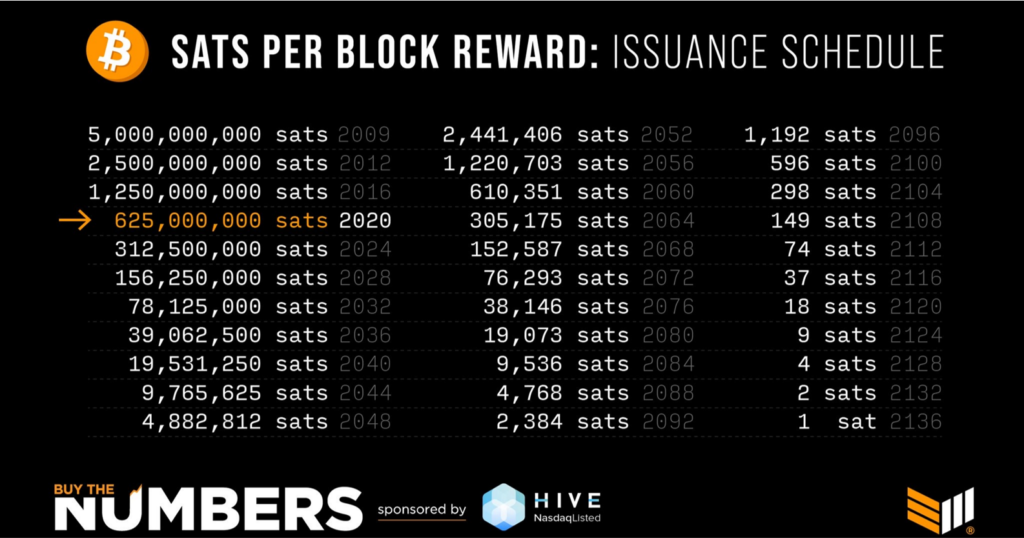
The timing of these halving events is assured by another hard coded bitcoin process known as the difficulty adjustment. Even if the number of miners multiplied by trillions in a couple of days, bitcoin’s difficulty adjustment would just change how much processing power it takes to mine a block, acting as an automatic pacemaker to keep the supply perfectly inelastic regardless of demand. Bitcoins difficulty adjustment is so powerful, all of the energy of the Sun could be funneled towards mining blocks and still no more bitcoin could be created any faster. The last ever bitcoin will take close to forty years to mine, and the final block reward will be sometime around the year 2140.
Bitcoin is money. It’s not a company or a product, therefore it doesn’t have cash flows and its value can’t be derived through familiar methods. Bitcoin is what’s known as a monetary good, and its value is instead derived from its ability to better satisfy the characteristics of good money. Some of these monetary attributes were described thousands of years ago by Aristotle and they still hold true to this day. They include durability, divisibility, fungibility, portability, verifiability, acceptability, and of course, scarcity.

Bitcoin has many qualities that make it good at being money and bitcoin’s absolute scarcity is one of the main differentiators. It is bitcoin’s superiority in satisfying these monetary attributes which makes it a better money than anything that has come before or since. Bitcoin’s mathematically provable absolutely scarce supply cap is the greatest assurance that value will be preserved into the future and can’t be diluted.
Economic actors are incentivized to choose the money that best holds its value across time, is most widely accepted, and most clearly conveys market pricing information. All three of these qualities are rooted in scarcity: resistance to inflation ensures that money retains its value and ability to accurately price capital across time, which leads to its use as an exchange medium
Robert Breedlove
When monies compete, scarcity often determines the winner. However scarcity isn’t about how rare an asset is, in fact commodities that are extremely rare to the point where no one owns them lack liquidity and therefore can’t even be used as money. Bitcoin has the advantage of being infinitely divisible so its rarity/finite supply doesn’t lessen it’s usefulness as money.
More important than rarity’s impact on scarcity is money hardness. Hard money refers to money that has an unforgeable costliness, where it isn’t easy to produce or counterfeit. Hard money also doesn’t loose it’s value quickly, but acts like a store of value for a long period of time. Money that grows on trees would be considered soft money, abundant and easy to make without much work, and inflates and loses value quickly. Gold is the classic example of hard money, because it takes a lot of work to mine, and can be stored for thousands of years without deteriorating.
If money is printed faster than the rate at which the economy grows, then each unit of currency will be worth less overall. This is the definition of inflation, and why bitcoin’s hard cap and halvenings make it inflation proof. A hard inflation proof money will always be more valuable in the long run than the alternative, which is why hard monies have historically replaced softer ones throughout history.
Bitcoin’s halving events reduce the rate at which bitcoin is mined, where every four years the amount of bitcoin mined in each block gets cut in half. This means that the number of bitcoins produced per year will get smaller and smaller as the limit of 21 million is approached.
In fact, there is only about 10% left of the bitcoin supply to be mined over the next 118 years, as the rate of bitcoin grinds to a halt. This in effect means that the total number of bitcoin (the stock) is much greater than new bitcoin being created (the flow).

This ratio of stock-to-flow is what gives a money it’s hardness, since this rate determines how much more currency will enter the market and dilute the existing stockpile. The harder the money, the more resistant it is to change in supply.
The total supply of gold increases at about 1.6% per year. If you divide the total amount of gold ever mined by the amount produced each year, you would get a stock-to-flow ratio of approximately 62. The ratio measures how many years it would take to double the supply.
Gold currently has the highest stock-to-flow of any commodity on earth. Having a high stock to flow ratio is actually quite an uncommon feature for commodities. Elements like rhodium are actually much rarer than gold, but due to rhodium’s importance in industrial processes, the total stockpile gets used up quite quickly so its stock-to-flow is lower. Gold has the advantage of being extremely chemically stable so its stockpile doesn’t erode over time, it’s been mined by humanity for thousands of years, and it is difficult to mine quickly.
Bitcoin’s current inflation rate is 1.7% and it’s current stock to flow is 57 which is quite similar to gold. When the block subsidy halving occurs in 2024 bitcoin’s stock to flow ratio will roughly double to about ~120, and in 2028 it will roughly double again to about ~240. Unlike gold the total supply of bitcoin will never double, and its stock to flow will keep multiplying to infinity.
Because of bitcoin’s terminal supply and halving events, bitcoin is the hardest money that has ever existed.
Throughout history many different items have been used as money. From beads and seashells, to stones, salt, and livestock. Over time, technological progress and financial incentives accelerated the production of these goods, decreasing their stock-to-flow, diluting their value and their usefulness as money.
However, interestingly enough, despite all improvements in technology the stock-to-flow ratio of gold and silver have remained relatively constant. This is because as we discovered better mining techniques easy deposits of these metals were depleted and only the harder to reach areas remained. As a result, gold and silver (whose stock-to-flow is second only to gold) were the main monies for thousands of years.
Whenever gold and silver (the monies with the highest stock to flow) came into contact with any other money, it was always gold and silver that won out. This is because as goods with the lowest debasement rate they were able to store their wealth better than other goods, making them more useful as money.
Eventually it was gold that succeeded over silver as the global reserve asset, as paper money derivatives made silver’s medium of exchange advantages obsolete. And then gold was of course eventually co-opted by governments and was replaced by fiat currencies due to their superior monetary attributes, divisibility, portability and verifiability. Weaknesses that bitcoin doesn’t have.

In the short run bitcoin’s supply issuance halvings historically have correlated with a cycle of price appreciation.
Every 4 years bitcoin’s price spikes and settles to new all time highs, closely following the supply shocks of the decrease in mining rewards. Additionally, bitcoin’s difficulty adjustment ensures perfect supply inelasticity, regardless of demand. This means that even though the monetary value of each block is increased, no matter how hard you dig you can’t inflate the supply. Any other commodity that rises in value incentivizes people to create more supply which then offsets the price rise.
Not so with bitcoin. As less bitcoin enters the market against its accelerating adoption rate, there isn’t enough supply to meet demand so the price rises. The price rise isn’t offset by increased production, so the price keeps rising. This accelerated rise usually follows a brief bout of hysteria and the price shoot higher than equilibrium in a FOMO mania that then results in a correction and a price crash.
It’s commonly understood that the real catalyst historically for price appreciation has been global liquidity, however as time goes on and accelerated global monetary liquidity continues to be entrenched, (either through transparent quantitative easing and yield curve control or via shadow liquidity injections through innovations in global financial plumbing) the inability for new bitcoin to be created will become an accelerated catalyst for price appreciation.
These cycles of user adoption, accumulation, supply decrease, and price appreciation are fed by bitcoin’s stock-to-flow ratio decreasing every four years, correlating with bitcoin hardening as money and growing increasingly scarce. Regardless of the short term volatility that the supply shocks initiate it’s bitcoin’s difficulty adjustment, perfect supply inelasticity, and hard cap which keeps bitcoin absolutely scarce and leads to its upward price trajectory over the long run.
However, the slowly dwindling new supply issuance isn’t the full story. The vast majority of bitcoin has already been mined so the largest amount of supply that could enter the market and dampen price appreciation would come from existing holders. A lot of great work has been done to examine the long term and short term holder supply and the potential impact on the market, specifically the work done by glassnode and The Rational Root. If you would like to explore those metrics further I can’t recommend their work highly enough.

In summary however, existing long term holders are the least likely to sell the majority of their holdings since these are exactly the people who understand bitcoin the most and are the most adamant of the evergreen price appreciation.
The absolute scarcity guarantees of bitcoin creates this feedback loop of bitcoin holder zealotry which in turn makes the asset even more scarce. We’ve recently hit an all time high in long term holder supply, with the vast majority of bitcoin locked up in cold storage.
I got a call [from billionaire hedge fund manager] Paul Jones and he says, “do you know that when bitcoin went from $17,000 to $3,000 that 86% of the people that owned it at $17,000, never sold it?” This was huge in my mind. So here’s something with a finite supply and 86% of the owners are religious zealots.
Stanley Druckenmiller
Bitcoin’s number-go-up (NGU) technology is driven by its absolute scarcity and exponential demand. And its exponential demand is driven by its fixed supply assurances. That’s far from the only reason, but it can’t be understated just how impactful a liquid and mathematically certain scarce monetary asset will be to the global financial system. Combining the fact that bitcoin is unique, its brand is one of the most recognizable in the world, and its adoption rate growing faster than the internet, its not long before bitcoin is impossible to ignore.
Bitcoin has no competition. No other money could ever match bitcoin’s level of scarcity. Its absolute scarcity will pull in value from all other store of value assets.

Money is a winner take all system, where the fewer monies to exchange is always preferred. And of course society will also have the incentive to adopt a good money over a bad ones. Government fiat currencies have failed over and over again over the course of hundreds of years, with the current epoch only existing for 50 years, a relatively short term economic experiment. They are prone to unsustainable leverage and inflation. Nation states have shown time and time again that they will always sacrifice monetary sustainability with short term political gain. This has ensured that government monies will always diminish in value over time.
Cryptocurrencies too don’t offer the same hard money assurances that bitcoin offers. The alternative future use cases for these cryptographic ledger technologies are vast and will be tested, however the use case for a superior money is by far the most disruptive on a global scale.
Absolute scarcity is a very layered phenomena that isn’t widely understood to date, and one which is very underestimated. There will never be more than 21 million bitcoin. That means there isn’t enough for each millionaire in the world to own a single bitcoin.
It is very hard to predict the impact bitcoin will have on the $10 trillion gold market, the $20 trillion art and collectibles market, the $100 trillion stock market, the $225 trillion real estate market and the $250 trillion bond market.
Alex Gladstein
Unlike gold or any money that came before it, because bitcoin is infinitely divisible it can store all of the value of the solar system, and still function as a liquid money, even with its supply cap.
It’s also important to note that prices are set by marginal sellers and buyers. One dollar into bitcoin doesn’t equal one dollar rise in price. As the price increases, if there are fewer and fewer people who would want to part with their bitcoin due to its superior hardness as money, the rate at which the price increase could be exponential.
As adoption climbs towards critical mass, and as bitcoin is identified as the global money with the greatest relative scarcity, bitcoin will shift more and more from a store of value asset into a medium of exchange. Its price will stabilize in an ‘S’ curve adoption fashion as its used less as a savings vehicle and more for the purchase of goods and services. This will cause the price to become moderately deflationary, matching the growth rate of the economy at large.
https://www.lynalden.com/what-is-money/
https://www.fidelitydigitalassets.com/sites/default/files/documents/bitcoin-first.pdf
Bitcoin: A Novel Economic Institution Ark Invest
https://medium.com/@nic__carter/in-support-of-the-proof-of-work-un-fair-launch-cd6e8f06358f
https://breedlove22.medium.com/the-number-zero-and-bitcoin-4c193336db5b
https://bitcoinmagazine.com/culture/bitcoin-is-a-trojan-horse-for-freedom
https://thehustle.co/stanley-druckenmiller-q-and-a-trung-phanin/